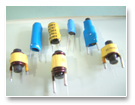
Ferrite rod inductors are passive electronic components that store energy in a magnetic field. They are characterized by their use of a ferrite core shaped as a rod, which significantly enhances their inductance compared to air-core inductors. This makes them ideal for various applications requiring specific inductance values and characteristics. This guide details the different types of ferrite rod inductors, categorized by several key features:
1. Based on Core Material:
2. Based on Winding Style:
3. Based on Physical Size and Shape:
Ferrite rod inductors come in a wide variety of sizes and shapes, catering to different space constraints and application requirements. Common sizes are often specified by the diameter and length of the ferrite rod. The physical dimensions directly impact inductance, current carrying capacity, and self-resonant frequency.
4. Based on Shielding:
Choosing the Right Ferrite Rod Inductor:
Selecting the appropriate ferrite rod inductor depends on several factors including: